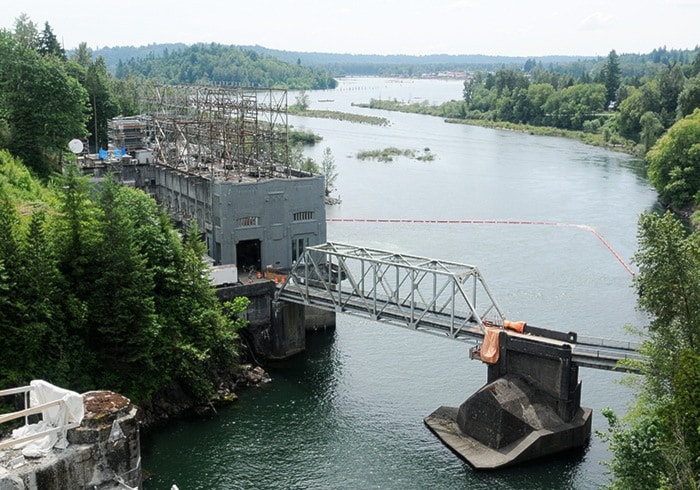The latest hike in B.C. Hydro rates means as, of this past April, the average homeowner is shelling out another $8 a month for electricity. And that will be followed by rate increases of nine per cent next year and six per cent in 2015.
Residents might feel better, though, knowing the increases are being used to renovate aging dams around B.C.
Energy and Mines Minister Bill Bennett made that point Wednesday following a tour of Ruskin Dam, which is halfway through its five-year, $748-million refit.
The project is on time and budget.
“If B.C. Hydro doesn’t invest in these types of kinds of older facilities, we’re going to end up not having reliable electricity that we’re accustomed to in B.C.,” Bennett said. “What that does, however, is put some pressure on rates. So those increases in rates are going to pay for projects like these.”
Liberal MLAs Doug Bing and Marc Dalton, along with Mission Mayor Ted Adlem, checked out the dam itself by walking along the top, where seven aging spillway gates from the 1930s are being replaced by five larger ones designed to withstand a one-in-10,000 year earthquake. The new gates will weigh twice that of the old ones.
“It’s double the amount of steel,” said project manager Boyd Mason.
That process involves removing the old towers between the gates by dismantling them block by block, then building new towers.
All the old concrete will be recycled, he pointed out.
To allow workers access the gates, a 262,000-kilogram wall or bulkhead has been set up to keep away 1,660 tonnes of water in the Hayward reservoir.
Mason, though, was most proud of a new asphalt-like material developed for a buried wall. The material can absorb shocks and can self-heal, preventing leaks from developing in the softer soil on the north side of the dam. That wall will attach to a longer buried wall of plastic concrete.
“This work has never been done before in North America.”
Still to be installed are the guts of the operation – three new turbines that will replace those from another age. The first turbine, or generator, is 84 years old. The second is 76 years old and the newest turbine was installed in the 1950s. However, the turbines were so well made that B.C. Hydro was able to refurbish rather than replace the rotor part, which turns within the turbine.
The new turbines largely will come from Brazil, and be eight-per-cent more efficient.
“In the turbine world, that’s huge,” said Mason.
Some dams have been refitted with new turbines or generators for only an additional half a per cent efficiency improvement, he said.
While the turbines can generate more power more efficiently, the waterflow over the dam remains the same, so there won’t be a major increase in power produced.
Still, the dam will be enough to power 33,000 homes in Metro Vancouver.
Adlem said the upgrade is the largest construction project Mission has seen.
“Certainly, the spin-offs from that money are huge. It’s a great, positive project.”
The Mission chamber of commerce created a handbook of local businesses so the contractor could easily find local services and suppliers.
B.C. Hydro says the project has injected $3 million into the local economy by using local sources for the heavy equipment, dump trucks, concrete and wood.
Bennett made the tour after announcing a policy change last fall, moving away from costly independent power producers, such as run of river projects, under which B.C. Hydro committed to buying power at high rates.
Hydro cancelled four electricity purchase contracts with independent power producers in August, and the total may reach 20 by the time a review of projects is complete.
“The bottom line, for me, is, I don’t want B.C. Hydro to be buying electricity, first of all that, they don’t need, and secondly, that is more expensive than they can obtain from other sources,” Bennett said.
Instead, Hydro wants to upgrade its existing systems, over 10 years, spending $1.7 billion yearly on projects, such as adding two generators to the Mica Dam north of Revelstoke or expanding capacity at the Revelstoke Dam.
“When we exhaust all of the low-cost sources of electricity, then we look at all of the other stuff that’s out there.”
Bennett said he likes windpower, which is constantly dropping in price. “But we don’t need any of it right now other than what we have in the pipeline.”
He agreed that’s a change from the government’s previous policy of signing on to run of river projects at energy prices above market rates.
He said the existing network of dams could supply power for another decade. After that, Hydro will look at cheaper ways of generating more power. That could be Site C, wind or natural gas.
“We’re going to do what’s in the best interests of ratepayers.”
